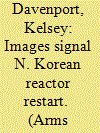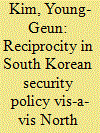| Srl | Item |
| 1 |
ID:
106321


|
|
|
|
|
| Publication |
2011.
|
| Summary/Abstract |
The future of the two Koreas has a great influence on the security landscape of Northeast Asia. Because of this, an exploration of a variety of future possibilities regarding the rapidly changing Korean Peninsula and preparation for a sudden change is timely in order to avoid any catastrophic result. This article suggests two likely scenarios for the future of the two Koreas and assesses these two by exploring critical uncertainties that lie ahead. It argues that internal conditions, such as the North's nuclear weapons program, its ongoing political transition process, and the policies of regional powers such as the United States, are the most important factors in determining future outcomes on the Korean Peninsula. Based on a thorough exploration of these critical uncertainties, it concludes that policy-makers of the South Korean government and regional powers should take seriously the possible North Korean collapse scenario, while making every effort to promote peace on the Korean Peninsula by creating a stable North Korea.
|
|
|
|
|
|
|
|
|
|
|
|
|
|
|
|
| 2 |
ID:
128084


|
|
|
|
|
| Publication |
2013.
|
| Summary/Abstract |
Satellite images indicate that North Korea is restarting a nuclear reactor that could produce plutonium for nuclear weapons in the future, analysts say, but one of the analysts estimates it will be about 18 months before Pyongyang will have more plutonium available for weapons.
In a Sept. 11 piece published by 38 North, a website run by the U.S.-Korea Institute at Johns Hopkins University, Nick Hansen and Jeffery Lewis concluded that satellite images from Aug. 31 showed steam coming from a building near the reactor that was consistent in "coloration and volume" with bringing the reactor's electrical generating systems online. The reactor is "in or nearing operation," said Hansen, a former military imagery analyst, and Lewis, the director of the East Asia Nonproliferation Program at the James Martin Center for Nonproliferation Studies.
|
|
|
|
|
|
|
|
|
|
|
|
|
|
|
|
| 3 |
ID:
157248


|
|
|
|
|
| Summary/Abstract |
On October 9, 2006, seismic stations around the world registered a seismic event centered near the village of Punggye-ri in the North Hamgyong province of North Korea. That was the first North Korean nuclear test. Since then, the issue of the North Korean nuclear program has entered a markedly different phase.
|
|
|
|
|
|
|
|
|
|
|
|
|
|
|
|
| 4 |
ID:
121734


|
|
|
|
|
| Publication |
2013.
|
| Summary/Abstract |
I review the principle of reciprocity in South Korean security policy with regard to North Korea and the United States and analyze how the principle fits with US security policy concerning South Korea. Diffuse reciprocity shaped Korean security policy starting with President Kim Dae-jung's Sunshine Policy. The Lee Myung-bak government's hard-line approach increased military tension and economic anxiety on the peninsula. The new South Korean government under Park Geun-hye should devise achievable policy measures rather than place excessive pressure or unrealistic demands on North Korea.
|
|
|
|
|
|
|
|
|
|
|
|
|
|
|
|